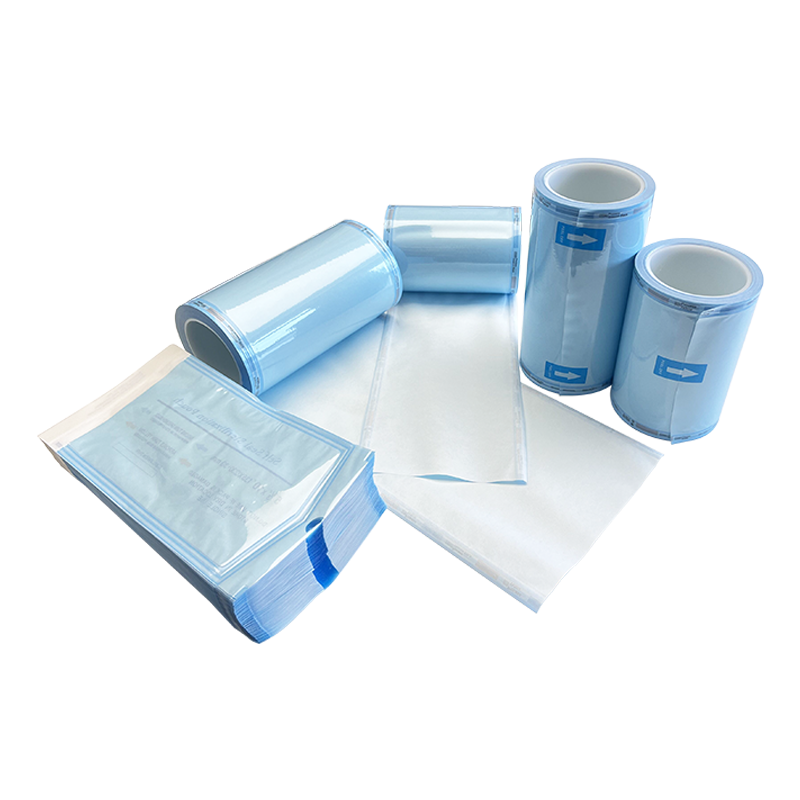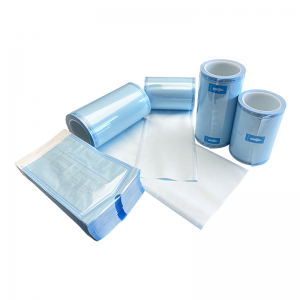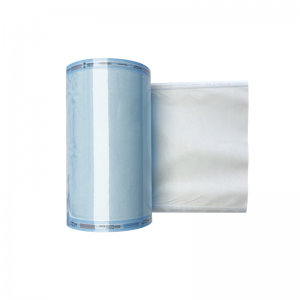Medical Sterilization Roll
The specification we offer is as follow:
| Gusseted Reel Size |
(55+25)mm X100m | (75+25)mm X 100m | (100+50)mm X100m |
| Gusseted Reel Size |
(125+50)mm X100m | (150+50)mm X 100m | (175+50)mm X100m |
| Gusseted Reel Size |
(200+55)mm X100m | (250+60)mm X100m | (300+65)mm X100m |
| Gusseted Reel Size |
(350+70)mm X100m | (400+75)mm X100m | (500+80)mm X100m |
| Flat Reel Size |
50mm X 200 | 55mm X 200 | 75mm X 200 | 100mm X 200 |
| Flat Reel Size |
125mm X 200 | 150mm X 200 | 175mm X 200 | 200mm X 200 |
| Flat Reel Size |
250mm X 200 | 300mm X 200 | 350mm X 200 | 400mm X 200 |
| Flat Reel Size |
500mm X 200 |
1. Preparation:
Select the appropriate width of the sterilization roll for the items to be sterilized.
Cut the roll to the desired length, allowing enough space for sealing both ends.
2. Packaging:
Place the items to be sterilized inside the cut piece of the sterilization roll. Ensure the items are clean and dry before packaging.
Ensure there is sufficient space around the items for steam or gas penetration.
3. Sealing:
Seal one end of the sterilization roll using a heat sealer. Ensure the seal is secure and airtight.
After placing the items inside, seal the open end in the same manner, making sure the seal is complete and free from gaps.
4. Labeling:
Write necessary information such as the date of sterilization, contents, and expiration date on the packaging, if required.
5. Sterilization:
Place the sealed package in the sterilizer. Ensure that the packaging material is compatible with the sterilization method (steam, ethylene oxide, or plasma).
Run the sterilization cycle according to the manufacturer’s instructions for the specific sterilizer being used.
6. Storage:
After sterilization, inspect the package to ensure the integrity of the seals and the color change of the chemical indicators, confirming successful sterilization.
Store the sterilized packages in a clean, dry, and dust-free environment until they are ready for use.
Hospitals:
Used for sterilizing surgical instruments, drapes, and other medical supplies in central sterilization departments and operating rooms.
Dental Clinics:
Ideal for sterilizing dental instruments and tools, ensuring they are safely packaged and ready for use.
Veterinary Clinics:
Used to sterilize veterinary instruments and supplies, maintaining hygiene and safety in animal care.
Laboratories:
Ensures laboratory equipment and materials are sterilized and free from contaminants, crucial for accurate testing and research.
Outpatient Clinics:
Used for sterilizing instruments used in minor surgical procedures and treatments, ensuring patient safety and infection control.
Ambulatory Surgical Centers:
Provides a reliable method for sterilizing surgical instruments and supplies, supporting efficient and safe surgical procedures.
Field Clinics:
Useful in mobile and temporary medical facilities for sterilizing instruments and maintaining sterile conditions in challenging environments.
Medical Sterilization Roll is a type of packaging material used in the healthcare industry to package instruments and other items that need to be sterilized. It consists of a durable, transparent plastic film on one side and a breathable paper or synthetic material on the other. This roll can be cut to any desired length to create custom-sized packages for various medical instruments.
Medical Sterilization Roll is used to package medical instruments and supplies that require sterilization. The roll ensures that these items can be effectively sterilized using various methods, such as steam, ethylene oxide, or plasma. Once the instruments are placed inside the cut piece of the roll and sealed, the packaging allows the sterilizing agent to penetrate and sterilize the contents while maintaining sterility until the package is opened.
Medical Sterilization Roll packaging refers to the process and materials used to encase and protect medical instruments and supplies that need to be sterilized. This packaging involves cutting the roll to the required length, placing the items inside, and sealing the ends with a heat sealer. The packaging material is designed to allow sterilizing agents to penetrate effectively while preventing contaminants from entering, thus ensuring that the instruments remain sterile until they are ready to be used.
Maintaining Sterility:
These materials help maintain the sterility of instruments after they have been sterilized. They provide a barrier that protects the contents from contamination until they are ready to be used.
Effective Sterilant Penetration:
Sterilization pouches and autoclave paper are designed to allow the sterilizing agent (such as steam, ethylene oxide, or plasma) to penetrate and sterilize the instruments inside. They are made from materials that ensure the sterilant reaches all surfaces of the instruments.
Breathability:
The materials used in these pouches and papers are breathable, allowing air to escape during the sterilization process but preventing microorganisms from entering afterward. This ensures that the internal environment remains sterile.
Visual Confirmation:
Many sterilization pouches come with built-in chemical indicators that change color when exposed to the correct sterilization conditions. This provides a visual confirmation that the sterilization process has been successfully completed.
Ease of Use:
Sterilization pouches and autoclave paper are easy to use. Instruments can be quickly placed inside, sealed, and labeled. After sterilization, the sealed pouch can be easily opened in a sterile manner.
Compliance with Standards:
Using these products helps healthcare facilities comply with regulatory and accreditation standards for sterilization practices, ensuring that all instruments are properly sterilized and safe for patient use.
Protection During Handling:
They protect instruments from damage and contamination during handling, storage, and transport. This is particularly important in maintaining the sterility and integrity of instruments until they are needed.
In summary, sterilization pouches and autoclave paper are essential for ensuring that instruments are effectively sterilized, remain sterile until use, and are protected from contamination and damage, thereby ensuring patient safety and adherence to healthcare standards.










